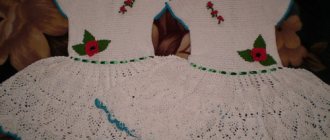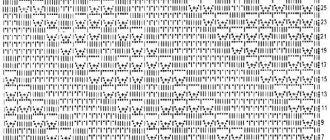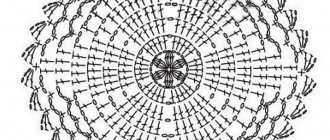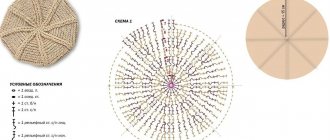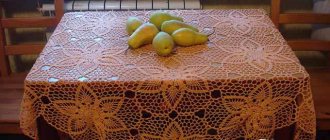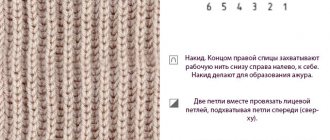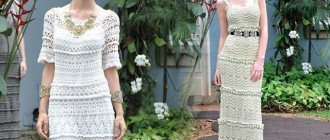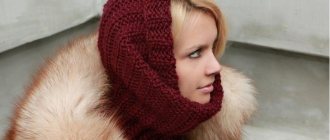Openwork women's jacket for summer
We will need:
- yarn (100% cotton, 120 meters per 50 grams), about 450 grams;
- cr. No. 2.5;
- 7 buttons.
Size for women: 36-38.
Basic knot: the number of loops is a multiple of 20 + 1 + 1 in. p.p.. We knit, adhering to the pattern. Beginning from st. before rap., repeat st. rap., end st. after rap.. Repeat 1-8 pp..
Border:
1 p.: p. without n..
2 p.: *1 p. without n., 1 “pico” (3 v. p., 1 ss. in the 1st v. p.), skip 1 p., 1 s. without n., repeat from * to *.
Basic knitting density knot: 19 p. x 11 r. = 10 x 10 cm; With. without n.: 21 p. x 20 r. = 10 x 10 cm.
Scheme
Pattern
Description
Back
We dial a chain of 81 v. p. + 1 v. p.p. and knit the base. knot..
After 45.5 cm = 50 rub. from the set we make another row like this: instead of 6 in. p. issue 4th century p. and, accordingly, on both sides from knitted together with. from 2 n. knit 5 in. P..
Knitting 46.5 cm = 51 r. from the set, leave the central 25 stitches for cutting the neckline and finish both sides separately. We knit 2 r. With. without n. and finish the job.
Left shelf
We collect a chain of 41 v. p. + 1 v. p.p., then we continue the work of the main. knot..
After 37.5 cm = 41 r. from the set we leave 11 stitches for cutting the neckline on the left side. We finish the work at a height. backrest, while issue. 51st row, as on the back, and finish 2 rows. With. without n..
Right shelf
Mirror left.
Sleeves
We collect a chain of 61 v. p. + 1 v. p.p., basic knot for 42 cm = 46 r., where we then knit 1 more row: instead of 6 in. p. issue 4th century p. and, accordingly, on both sides from knitted together with. from 2 n. we knit 5 in. p.. Next we knit 1 row s. without n. and finish the job.
Assembly
Vol. seams on the shoulders: we sew in the sleeves, sew the product on the sides, and then sew the sleeves. We tie the bottom, neckline and edges of the sleeves with a border, while in the second row on the right shelf it is equal. issue 7 loops (= 1 v. p. between “pico” and s. without n.). Sew on the buttons and the openwork crochet jacket for women is ready!
Decoding circuits for beginners
For many beginning needlewomen, the stumbling block is diagrams and incomprehensible drawings, which seem impossible to understand. But in reality there is nothing complicated. To record a pattern, they use notation so that instead of several sheets of description text, refer to only one drawing. It is important to remember that:
- loops that are located outside the section are knitted only at the very end and at the beginning of the row;
- the diagram itself is read from bottom to top;
- the rows are knitted alternately, first from right to left, then from left to right;
- circular rows are always created from right to left;
- rapport requires repetition from arrow to arrow.
Crocheting is a meditative process. And in order not to be nervous when making a jacket, you just need to remember the symbols on the diagrams. The air loop looks like an empty circle, the lifting loop looks like a filled circle. A half-column is drawn with a plus sign, and a column with a vertical stick. On the last one they put a small horizontal line, which indicates a yarn over.
To simplify visual perception, it is better to use a ready-made picture. All diagrams are usually marked separately so that the needlewoman does not make mistakes during the work process. Often on Russian and even foreign forums you can find hand-drawn diagrams where the same notations are used. This allows you to read patterns invented by needlewomen in other countries.
Crocheting for women is not only a pleasant pastime. This is also an opportunity to create unique things for yourself and your family. Making quality handmade clothing can eventually turn from a hobby into a real business.
Yellow long jacket for women for autumn
We will need:
- yarn (100% wool, 100 meters per 50 grams), deep yellow color;
- cr. No. 4.5;
- 6 buttons.
Sizes for women: S, M, L, XL, XXL, XXXL.
Knitting density: 17 p. x 6 p. knot A4 = 10 cm wide (1 rap. knot. A1 = 3.5 cm, 1 rap. knot. A2 = 3 cm, 1 rap. knot. AZ = 2.5 cm, 1 rap. knot. A1/A2/ AZ = 2.5 cm vertically).
R. from the village. without n.: beginning each R. from 1st century p. (we do not take it into account for the 1st s. without n.), 1 s. without n. in each p. row, p..
Uz. A1 (cr. 6 + 1 p.):
1 rub. (LS): 4 c. p. (= 1 s. with 2 n.) in the 1st s. without n., *2 v. p., 1 cone out of 5 s. from 2 n., 2 v. p., 1 p. from 2 n. in the next With. without n.*, from * to *, turn.
2 r. (IS): 1st century. p., 3 p. without n. to 1st A from c. p., 1 p. without n. in the next bump, 2 s. without n. in the next A from c. p., *1 p. without n. in the next With. with 2 n., 2 s. without n. in the next A from c. p., 1 p. without n. in the next bump, 2 s. without n. in the next A from c. p.*, from * to *, end at 1 s. without n. more recently A from c. n. in r..
Uz. A2 (cr. 5 + 1):
1 rub. (LS): 4 c. p. (= 1st s. with 2 n.) in 1st s. without n., *2 v. p., 1 cone out of 4 s. from 2 n., 2 v. p., 1 p. from 2 n. in the next With. without n.*, from * to *, turn.
2 r. (IS): 1st century. p., 3 p. without n. to 1st A from c. p., prop. 1st bump, 2 s. without n. in the next A from c. p., *1 p. without n. in the next With. with 2 n., 2 s. without n. in the next A from c. p., prop. sl. bump, 2 s. without n. in the next And from va. n.*, from * to *, end the row at 1 s. without n. more recently A from c. p. in a row.
Uz. AZ (cr. for 4 + 1 p.):
1 rub. (LS): 4 c. p. in the 1st s. without n., *1 v. p., bump from 3 s. from 2 n., 1 v. p., 1 p. from 2 n. in the next With. without n.*, from * to *, turn.
2 r. (IS): 1st century. p., 2 p. without n. to 1st A from c. p., 1 p. without n. in the next bump, 1 s. without n. in the next A from c. p., *1 p. without n. in the next With. with 2 n., 1 s. without n. in the next A from c. p., 1 p. without n. in the next bump, 1 s. without n. in the next A from c. n.*, from * to *, order. for 1 s. without n. more recently A from c. P..
Increases: knit 2 p. in 1 p.
R. from the village. from n: via PM, beginning. from 3rd century n. (= 1st s.n.), prop. 1st s. without n. etc., 1 s. s n. in each With. without n., turn.
Uz. A4:
1 rub. (LS): p. with n..
2 r. (IS): p. without n..
Decrease s. with n..
Ub. 2 s. s n. vm. like this: knitting 1 p. s n. in the village without n. below, but not vol. last pulling the thread (= 2 stitches on the edge), another 1 s. s n. in the next With. without n., but without last. broach, then we pull the thread through all the stitches on the edge. = 1 s. s n. kill..
Ub. 3 s. s n. in the beginning. or con. r., prov. first 6 or last 6 p. s n. vm. 2 x 2.
Ub. 2 s each s n. in the beginning. or con. r., prov. first 4 or last 4 s. s n. vm. 2 x 2.
Ub. 1 s. s n. in the beginning. or con. r., prov. first 2 or last 2 s. s n. vm..
Ub. With. without n.: let's start a cr. in the paragraph below and pull out the thread, start the cr. in sl.. p. and vt. thread, yarn over and pull the thread through all 3 stitches on the edge. = 1 p. dec..
Knitting in the round for the belt: after last. With. without n. in knitting in the round, not finished. 1 ss., and continue like this: in the next. R. in a circle issue. 1 p. without n. in the 1st s. without n. prev R. round.
Knitting density: 17 p. x 6 p. knot A4 = 10 cm (1 rap. knot. A1 = 3.5 cm, 1 rap. knot. A2 = 3 cm, 1 rap. knot. AZ = 2.5 cm, 1 rap. knot. A1/A2/AZ = 2.5 cm vertically).
Schemes, patterns and symbols
Description
Openwork knot. rotary pp. from the middle of the front.
188, 200, 218, 242, 266, 290 v. p., p., 1 p. without n. in the 2nd century. p., 1 p. without n. in each V. p., p..
Then another 4 rubles. from the village without n..
Openwork knot. A1 = 31, 33, 36, 40, 44, 48 rap. + 1 s. from 2 n..
Openwork knot. A1 only x 6, 6, 7, 7, 8,8, but we knit the last one. R. from the village without n. according to IS: 1st century. p., 3 p. without n. to 1st A from c. p., prop. 1 cone, 2 s. without n. in the next A from c. p., *1 p. without n. in the next With. with 2 n., 2 s. without n. in the next A from c. p., prop. sl. bump, 2 s. without n. in the next A from c. n.*, from * to *, order. 3 s. without n. in the last A from c. p., p..
Next is the openwork knot. A2. When is the 2nd r. knot will be issued = 156, 166, 181, 201, 221, 241 pp. without n. in the river Prov. knot A2 is only x 6, but the last one. R. from the village without n. according to IP we change: 1 c. p., 2 p. without n. in 1st A from c. p., 1 p. without n. in the next bump, 1 s. without n. in the next A from c. p., *1 p. without n. in the next With. with 2 n., 1 s. without n. in the next A from c. p., 1 p. without n. in the next bump, 1 s. without n. in the next A from c. n.*, from * to *, order. 2 s. without n. in the last A from c. P..
Knitting openwork knot AZ. After the 2nd r. knot = 125, 133, 145, 161, 177, 193 s. without n.. Stuck. knot AZ total x 6, in the last p. from the village without n. according to IS equal. approx. 10, 12, 14, 16, 18, 20 s. without n..
Uz. A4 x 1, at the same moment in the river. from the village without n. according to IS equal. approx. 9, 11, 13, 11, 13, 15 p.. Prov. openwork knot A4 total x 6, 7, 7, 8, 8, 9, do not cut the thread.
Place a marker (hereinafter referred to as M) on the 36th, 39th, 43rd, 47th, 52nd, 57th s. without n. from each side, in the last R. from the village without n..
Right shelf
36, 39, 43, 47, 52, 57 pp. without n., then knot. A4, at the same moment issue. ub. for opening in sl. persons r.: s. s n. to last 3 s. without n. before M = 33, 36, 40, 44, 49, 54 s. from n., p.v. (= prop. 3 sts before M) and knit a row of s. without n. according to IS. After this issue. ub. for washing at the end of each persons rub. 3 s. s n. x 0, 0, 1, 1, 1, 2, 2 s. s n. x 1, 1, 1, 3, 4, 5 and 1 s. s n. x 1, 3, 3, 2, 3, 1.
At the same moment, when the bond. A4 will be knitted in total x 5, 6, 6, 6, 6, 6 (we take into account from M in the last row from the s. without n. before the kill for the promochka), issue. ub. for the neckline in the next persons R. from the village s n: cut the thread, knit 3 in. p. (= 1 s.s.) in 7th, 7th, 8th, 8th, 9th, 9th s. without n. from the center of the front part (= prop. 6, 6, 7, 7, 8, 8 s.n. from the center of the front part), knit with. with n.. At the same moment cont. track. way: issue. ub. for a hole at the end of the row, as indicated, turn and knit 1 row. from the village without n. according to IS. Next issue. ub. for the neck at the beginning. each persons rub. 2 s. s n. x 2 and 1 s. s n. x 2. When everything is killed. will be done, there will be 18, 19, 19, 20, 21, 23 sts left for the shoulder.
We tie a knot. A4 total x 11, 12, 13, 13, 14,14 (we take into account from M in the last row from the s. without a n. before the kill for the hole), high. work 76, 80, 84, 86, 89, 91 cm (order 1 p. from s. without n.), cut the thread and fasten it.
Left shelf
36, 39, 43, 47, 52, 57 pp. without n..
We knit a knot. A4, at the same moment issue. ub. for opening in sl. persons r.: prop. first 3 s. without n. from M on the side, knit 3 ins. n. (= 1 s. n.) in the next. With. without n. (= 4th s. without n. from M), s. s n. = 33, 36, 40, 44, 49, 54 s. from n., p.v. and knitting 1 rub. from the village without n. according to IS. Next issue. ub. for washing at the beginning. each r. via PM: ub. 3 s. s n. x 0, 0, 1, 1, 1, 2; 2 s. s n. x 1, 1, 1, 3, 4, 5 and 1 s. s n. x 1, 3, 3, 2, 3, 1. At the same moment when the knot. A4 will be knitted in total x 5, 6, 6, 6, 6, 6 (we take into account from M in the last row from the s. without n. before the kill for the promochka), issue. ub. for the neckline in the next persons R. from the village from n.: issue. ub. for washing at the beginning. r., as indicated, knitting. With. s n. to last 6, 6, 7, 7, 8, 8 s. s n. from the center of the front, turn. and knit 1 p. from the village without n. according to IS. Vol. ub. at the end of each persons rub. 2 s. s n. x 2 and 1 s. s n. x 2. When all the decreases are knitted, we get 18, 19, 19, 20, 21, 23 sts for the shoulder.
We tie a knot. A4 total x 11, 12, 13, 13, 14, 14 (we take into account from M in the last row from the s. without n. before the kill for the hole), high. the product is 76, 80, 84, 85, 89, 91 cm (order 1 p. from the s. without n.), cut and fasten the thread.
Back
72, 78, 86, 94, 104, 114 pp. without n.. Cont. knot A4, at the same moment issue. ub. for holes in sl. persons r.: prop. 3 s. without n. from M on the right side of the part, we knit Z in. p. in the next With. without n. (= 1st s. with n. in 4th s. without n. from M), 1 s. s n. in each With. without n. to last 3 s. without n. at the next M = 66, 72, 80, 88, 98, 108 s. from n., p.v. (= prop. 3 s. without n. on each side), 1 row of s. without n. according to IS. Vol. ub. for openings at the beginning. and con. every R. via PM: ub. 3 s. s n. x 0, 0, 1, 1, 1, 2; 2 s. s n. x 1, 1, 1, 3, 4, 5 and 1 s. s n. x 1, 3, 3, 2, 3, 1 = 60, 62, 64, 66, 70, 74 p.. We tie a knot. A4 total x 9, 10, 11, 11, 12, 12 (we take into account from M in the last r. from the s. without n. before the dec for a hole).
Right shoulder
By LAN prov. 19, 20, 20, 21, 22, 24 s. from n., p.v. and knitting 19, 20, 20, 21, 22, 24 s. without n. according to IS, pov.. In the following. R. by PM ub. 1 p. s n. at the end of the river for the neck = 18, 19, 19, 20, 21, 23 s. s n. for the shoulder. Prov. 1 rub. from the village without n. according to IS = total 11, 12, 13, 13, 14, 14 rap. knot A4 (we take into account from M in the last r. from s. without n. before ub. for the armhole), cut and fasten the thread, high. blanks 76, 80, 84, 85, 89, 91 cm.
Left shoulder
By PM, beginning. from the neckline: count 19, 20, 20, 21, 22, 24 sts from the left side and the beginning. from the west century p. in this s. without n.. Continue knitting. 1 p. s n. in each from 18, 19, 19, 20, 21, 23 pp. s n. along the row (that is, we do not knit the central 22, 22, 24, 24, 26, 26 p. = neckline.). Turn and knit. 1 s. without n. in every s. with n., turn. In the words R. (= s. s n.) ub. 1 p. s n. in the beginning. R. for the neck = 18, 19, 19, 20, 21, 23 s. with n.. Prov. 1 rub. from the village without n., cut and fasten the thread, high. blanks 76, 80, 84, 85, 89, 91 cm.
Sleeves
Rotary pp..
Loose knit 37, 37, 42, 42, 47, 47 centuries. p., p. and knitting 1 p. beh n. in the 2nd century. p. from cr., after which 1 s. without n. in each V. p. along the river = 36, 36, 41, 41, 46, 46 s. without n., p.. Prov. 4 more rubles from the village without n. = only 5 rub. from the village without n.. Next knit. knot A2 = 7, 7, 8, 8, 9, 9 rap. + 1 s. from 2 n..
Prov. knot A2 is only x 3, but in the last one. R. from the village without n. according to IS equal. approx. 0, 4, 2, 4, 6, 8 s. without n. = 36, 40, 43, 45, 52, 54 s. without n.. Continue knitting. knot A4 until work is completed. At the same moment, arrival. 1 s. s n. on the extreme villages without n. from two tbsp. on the 1st from the village s n. = 2 s. s n arr.. Repeat. approx. from two tbsp. in each 2nd r. from the village s n. (i.e. in every 4th row) another x 8, 8, 8, 8, 7, 7 = 54, 58, 61, 63, 68, 70 p.. Continue until knot. A4 will not be wired. total x 21, 21, 20, 20, 19, 19 (last r. = r. from village without n. according to IS).
Vol. ub. for rolling sleeves in sl. R. from the village s n. via PM: ss. until 4th s. without n., 3rd cent. p. in this s. without n. (= 1st s.s.), 1 s. s n. in each With. without n. to last 3 s. without n. in the river = 48, 52, 55, 57, 62, 64 s. from n., p.v. and prov. 1 rub. from the village without n. according to IS.
Cont. issue ub. for rolling sleeves with two tbsp. in each persons rub. 3 s. s n. x 1, 2, 2, 2, 2, 2; 2 s. s n. x 2, 2, 2, 3, 4, 4, 1 s. s n. x 1, 0, 1, 1, 1, 1, 2 s. s n. x 2, 2, 2, 1, 1, 1. In next. persons R. ub. 3 s each s n. on both sides. In the words purl R. ub. 3 s each without n. from two stitches, cut and fasten the thread.
The second sleeve is knitted in the same way.
Assembly
Conn. shoulder seams, no. stitches in the front lobes of the outer stitches. We sew the sleeves into the armholes, no. sleeve seams.
Collar
By LS knitting. 80-100 s. without n. along the neck, beginning from the top of the right shelf, then 1 p. With. without n. according to IS, we adjust the number of points to 80, 82, 84, 88, 92, 94 s. without n. + 4 more rubles from the village without n. = 6 rub. nw s. without n..
In the words R. equal approx. 3 s. without n. along the river = 83, 85, 87, 91, 95, 97 s. without n.. Continue knitting. With. without n., vol. only 11 rub.. In the next R. from the village without n. equal approx. 3, 6, 4, 5, 6, 4 s. without n.
After prov. knot A2 1 time and 2 more times. from the village without n., cut and fasten the thread.
Planks
By LS 130-150 s. without n. along the front edge of the right shelf, then 1 p. from the village without n. according to the IS, in which we adjust the number of points to 128, 134, 138, 140, 144, 148 s. without n.. In the words. R. according to LS knitting: p. without n. to last 80, 84, 84, 84, 88, 90 pp. without n. in r., *2 v. p., prop. 2 s. without n., 13, 14, 16, 17, 17, 18 p. without n.*, from * to * another x 1, 2 c. p., prop. 2 s. without n., knitting 12 s. without n., 2nd century. p., prop. 2 s. without n., prov. last 2 s. without n. in r., p..
Then another 2 rubles. from the village without n. (knit 2 s. without n. in each A from v. p.), cut the thread and fasten = 5 r. from the village without n. Total.
We knit the left placket in the same way, but without holes for buttons. Sew on 4 buttons.
Belt
We knit in a circle. We dial 19th century. p., p., 3 s. without n. in the 2nd century. p. from cr., after which 1 s. without n. in each V. p. to last V. p. in r., 3 p. without n. in the last V. p., p. detail.
Next knit. in a circle for 1 sec. without n. in each V. p. on the other side of the initial river. from in. p.. In the next knit in a row in a circle. 1 s. without n. in each With. without n., but on two short sides approx. 1 s. without n. (wire 2 s. without n. in the same s. without n.) in each. from central 3 s. without n..
Cont. do the same further (knit in the round and sew out on short sides) until the length of the belt is 14, 14, 15, 15, 16, 16 cm. 1 ss. in the next With. without n., cut and attach the thread.
We place the belt in the middle of the back and sew 1 button on each. sides of the belt.
The yellow crochet jacket for women is ready!
Jacket patterns
View > Home
07 Nov 2021, Tatyana Category: Shawl, scarf, Knitting patterns, Shawl patterns, Summer blouse patterns, Knitting for women, For beginners, Poncho, cape, Miscellaneous, Collections, Stole patterns, Bolero patterns, Jacket patterns, For summer
your feedback
Crocheted capes are highly valued by fashionistas and are one of the must-have items in a woman's wardrobe. No less popular are children's capes and capes, which caring mothers and grandmothers knit with trepidation for their beloved babies. Read completely
Tags:
May 04, 2021, Tatyana Category: Knitting competitions, Knitting patterns, Knitting for women, Jacket, pullover, Readers' works, Jacket patterns, Knitting for spring, Openwork knitting
your feedback
Competition work No. 9 - Openwork jacket (competition conditions)
Author of the work: Aliya Khasanova
Openwork black jacket made of acrylic and cotton, crocheted No. 3, LIRA yarn. It took 5.5 skeins, knitted according to the pattern that I attach along with the work, tying sc and picot, at intervals of 5 loops, I also crocheted the parts, sewed on buttons.
Read completely
Tags: Crochet jacket, Knitted jacket
March 13, 2021, Tatyana Category: Knitting competitions, Knitting patterns, Knitting for women, Jacket, pullover, Works of readers, Skirts, trousers, Jacket patterns, Best work of March, Skirt patterns
your feedback
Competition work No. 10 - Japanese jacket and crochet skirt (competition conditions)
I liked this Japanese jacket. Everything is clear on the diagrams, there is even a pattern, knitted from thin wool blend in 2 folds, crochet number 2.
I sewed the finished product and decorated it with frills - they made the jacket look like it was vintage. There was a lot of thread and it was hanging onto the skirt.
Read completely
Tags: Skirt, Crochet skirt, Crochet jacket, Knitted jacket
March 29, 2021, Tatyana Category: Knitting patterns, Knitting for women, Jacket, pullover, Works of readers, Jacket patterns, Best work of March
your feedback
Competition entry No. 66 – Jacket using Irish lace technique (Valentina Nikiforova)
I started knitting when I was 10 years old. My mother taught me to knit. Since she only knew how to knit with knitting needles, she taught me this skill. But my desire to learn new types of knitting grew over the years. I learned to crochet, first napkins, and then moved on to dresses, skirts, suits and hats.
But my craving for knitting did not subside. When new magazines began to appear, where models knitted using the Irish lace technique appeared, I was completely delighted with this skill. And I decided to master it.
Women's green jacket is made of Yarn art tulip.
Read completely
Tags: Irish lace, Crochet jacket, Knitted jacket
02 March 2021, Tatyana Category: Knitting competitions, Knitting patterns, Knitting for women, Jacket, pullover, Works of readers, Jacket patterns, Best work of March
your feedback
Competition work No. 10 - Jacket made of motifs (Elena Skryabina) - competition conditions
Hello, my name is Elena Skryabina. I have been knitting all my adult life, I started with knitting needles and gradually switched to crochet. Knitting is my outlet, I can’t live a day without picking up a hook..)
Jacket made of motifs, yarn ANNA 16, 100% cotton, 100g.-530m., hooks No. 1.75 and No. 2. It took almost 500 grams.
Read completely
Tags: Jacket, From motifs, Competition, Crochet jacket, Knitted jacket
20 Aug 2015, Tatyana Category: Knitting patterns, Knitting for women, Jacket, pullover, From magazines, Jacket patterns
your feedback
An interesting knitted jacket with a zipper combines an openwork crocheted pattern and dense strips made on knitting needles.
Read completely
Tags: Knitting for women, Crochet jacket, Knitted jacket
May 21, 2015, Tatyana Category: Knitting patterns, Knitting for women, Jacket, pullover, Jacket patterns
your feedback
Crocheted with an expressive lace pattern, this jacket with ties is appropriate for any setting.
Size: 38/40
You will need: 550 g of green Secondo yarn (55% cotton, 25% polyamide, 20% silk, 125 m / 50 g); hook number 3.
Attention! We recommend making the pattern in full size.
Read completely
Tags: Jacket, Crochet jacket, Knitted jacket
22 Sep 2014, Tatyana Category: Knitting patterns, Knitting for women, Jacket, pullover, Jacket patterns
your feedback
A warm, voluminous jacket with a wide, knitted shawl collar will become a favorite item for a long time.
Dimensions: 38/40 (44) 46/48
You will need: 850 (900) 950 g of pink Paloma yarn (60% alpaca wool, 40% sheep wool, 64 m/50 g); knitting needles No. 9 and hook No. 10; 1 button.
Facial surface: faces. R. - persons p., out. R. -outside P.
Read completely
Tags: Knitting for women, Crochet jacket, Knitted jacket
22 Sep 2014, Tatyana Category: Knitting patterns, Knitting for women, Jacket, pullover, Jacket patterns
your feedback
Need a long striped jacket in beautiful natural shades? One option made from unusually soft yarn is in front of you.
Dimensions: 38/40 (42/44) 46/48
You will need: 600 (700) 700 g of melange yarn in brown tones Linie 310 Alpaca degrade (100% alpaca wool, 180 m/100 g); 1 wooden button; hook No. 5; long circular knitting needles No. 4.5.
Read completely
Tags: Crochet jacket, Knitted jacket
06 Aug 2014, Tatyana Category: Knitting patterns, Knitting for women, Jacket, pullover, Jacket patterns
your feedback
It will be very useful to meet the first days of September in this jacket. The bright shade of cotton yarn will not only preserve summer memories, but also inspire new adventures in the fall!
Size: 44/46 (Russian Federation)
You will need: 300 g of orange yarn (No. 164) Alpina XENIA (100% mercerized cotton, 240 m/50 g); hook No. 2; 5 buttons.
Read completely
Tags: Crochet jacket, Knitted jacket
July 19, 2014, Tatyana Category: Knitting patterns, Knitting for women, Jacket, pullover, Large sizes, Jacket patterns
your feedback
White jacket with slanted fronts
Size: L-XL
You will need: ribbon yarn (30% cotton, 70% polyamide, 420 m/100 g) - 300 g white, Violet yarn (100% mercerized cotton, 282 m/50 g) - 50 g white, knitting needles no. 3.5, hook No. 2.
Read completely
Tags: Crochet jacket, Knitted jacket, Plus size fashion
June 10, 2014, Tatyana Category: Knitting patterns, Knitting for children, Sweatshirts, sweaters, Jacket patterns
your feedback
In such a stylish jacket, your baby will be the most fashionable.
For 6-7 years
You will need: Cotton Gold yarn (55% cotton, 45% acrylic, 330 m/100 g) - 200 g white, Cotton Soft yarn (55% cotton, 45% acrylic, 600 m/100 g) -100 g brown , hook No. 3, 6 buttons.
Read completely
Tags: Crochet jacket, Knitted jacket
Page 1 of 91…End »
Openwork cape jacket for women made of floral motifs
We will need:
- yarn (100% cotton, 700 meters per 150 grams);
- cr. No. 2.
Women's size: 38
Cone: 3 in. p. and 1 ss. to the base point..
Fan: in 1 p. 2 s. from N., 2nd century. p. and 2 s. with n..
Pattern of fans (cr. 6 + 1 row): hold. schemes 1.
Flower: holding. diagrams 2. The connection of floral motifs is carried out according to the diagram.
Mesh pattern: hold. schemes 3.
Knitting density:
- pattern of fans: 30 p. x 14 r. = 10 x 10 cm;
- flower: diameter = 5 cm;
- mesh pattern for sleeves: 11 A x 12 r. = 10 x 10 cm.
Scheme, pattern and symbols
Jacket-cape: description
Back
We knit 48 floral motifs and connections. there are 8 x 6 motifs. For lower knitting planks along the bottom edge.
1 p.: 1 s. s n. in the central V. n. corner A of the 1st flower, *2 s. s n. in corner A, 4 s. s n. in the next 4 s. with 2 n., 2 s. s n. in the next A, 4 s. s n. in the next 4 s. with 2 n., 2 s. s n. in the next A, 1 p. s n. in place of connection corner A 2 flowers*, from * to * to end. r., prov. last With. s n. last repeat in central V. n. corner A of the 8th flower, p..
2 p.: 1 s. s n. in 1st p., * 1st c. p., pass. 1 p., 1 s. s n. in the next n.*, from * to *, p..
3 p.: 1 s. s n. in 1st p., *1 p. s n. in the next A, 1 p. s n. in the next.. with. from n.*, from * to *, turn..
4 p.: 1 s. s n. in the next p., 1st century p., pass. 2 p., * 1 fan in next. p., 3 c. p., pass. 5 p.*, from * to *, at the end of the p. 1 fan in sl. p., 1st century p., pass. 2 p., 1 s. s n. in the last p., p..
5-21 pp.: 1 s. s n. in 1st paragraph, 1st century. n., *1 fan in next. And from 2nd century. p., 3 c. p., pass. And from the 3rd century. p.*, from * to *, con. R. 1 fan in sl. p., 1st century p., 1 p. s n. in the last p., p..
22 rubles: 1 s. without n. in the 1st p., 1 bump, *1 s. without n. in the next With. s n., 1 cone, 2 s. without n. in the next A, 1 cone, 1 s. without n. in the next With. from N., 3rd century. p., pass. 3 p.*, from * to *, in the end. R. 1 p. without n. in the next With. s n., 1 cone, 2 s. without n. in A, 1 cone, 1 s. without n. in the next With. s n, 1 cone, 1 s. without n. in the last P.; cut and fasten the thread.
Right shelf
Knitting 18 flowers and conn. there are 3 x 6 of them; conn. also top strip of 3 flowers (shoulder bevel) with 3 flowers, forming. right shoulder of the back.
Knitting There is a strip along the bottom, like for the back, equal. ub. at 3 p.m. planks 3 p. with n..
Left shelf
Knitted like the right one, conn. top a strip of 3 flowers with 3 flowers on the left shoulder of the back (in the middle of the upper edge of the back there will be 2 free flowers forming the neck).
Sleeve
We knit 5 motifs, conn. them into a strip. Knit along the top. mesh as described below.
1 p.: 1 s. s n. in the central V. p. upper corner A of the 1st flower of the strip (replace the 1st st. from each r. with 3 v. p. p.), 2 v. p., *°1 s. without n. in the 3rd century n.sl. A, 5th century. p., pass. sl. With. with 2 n., 1 s. without n. in the next With. from 2 n., 5 c. p., 1 p. without n. in the next With. from 2 n., 5 c. p., 1 p. without n. in the 3rd century n.sl. A°, 5 in. p.*, from * to * another x 3, from ° to ° x 1, 2 c. p., 1 p. s n. in the central V. p. upper corner A of the 5th flower, turn., 1 in. P..
Further along the line, repeat. rap. from 2nd r. After 35 cm from the cuff we knit 1 r. from A to connect. sleeve with an armhole, before this issue. side seams 20 cm from the bottom, sewing half corner A, 4 s for the first 3 motifs. from 2 n., 3 c. p., 4 p. with 2 n., and half a word. A; for the 4th flower we sew half of the corner A, 4 s. from 2 n., 3 c. p. and 4 s. from 2 n..
Last r.: 1 s. without n. in 1st p., 2nd v. p., 1 p. without n. in the side seam, 2 in. p., 1 p. without n. in the central V. n.sl. And from the 5th century. p. sleeve, *°2 in. p., 1 ss. in the 3rd century n. A from the 11th century. p. flower, 2 in. p., 1 p. without n. in the central V. n.sl. A sleeve, 2 in. p., 1 ss. in the 3rd century n. A from the 11th century. n.sl. flower, 2 c. p., 1 p. without n. in the central V. n.sl. A sleeve, 2 in. p.°, 1 ss. in the 4th s. from 2 n. flower, 2 c. p., 1 p. without n. in the central V. n.sl. A sleeve, 2 in. p., 1 ss. in the next With. from 2 n. flower, 2 c. p., 1 p. without n. in the central V. n.sl. And sleeves*, from * to * x 3 more, from ° to ° x 1, 1 ss. in the side seam, 2 in. p., 1 p. without n. in the last With. with n.; cut and fasten the thread.
Tie
Vol. chain of 31st century. p. + 1 v. p.p..
1 p.: 1 s. without n. in the 2nd century p. from cr., 1 s. without n. in each from the words 30th century p., p..
2 p.: 1 s. s n. in 1st p., * 1st c. p., pass. 1 p., 1 s. s n. in the next p.*, from * to *, turn, 1st century. P..
3 p.: 1 s. without n. in the 1st paragraph, *skip. 1 A from 1 v. p., in the next A 7 s. with n., pass. 1 A from 1 v. p., 1 p. without n. in the next A*, rev. from * to *, rot..
4 p.: 1 s. without n. in 1st p., 2 x (3 v. p., 1 s. without n. in 1st of 3 v. p.), 3 x (pop. 1 s. with n., in next s. with n. knitting: 1 s. with n., 1 cone and 1 s. with n.)*, from * to *, in end. R. 2 x (3 v. p., 1 s. without n. in 1st of 3 v. p.), 1 s. without n. in the last With. without n.; cut and fasten the thread. We knit the second tie in the same way.
Summer cape: assembly
Vol. seams of sleeves. We tie the central edges of the shelves and the neck.
1 p.: p. without n., prov. 2 s each without n. in each lateral wall of the outermost s. s n. bottom strip of shelves, 3 s. without n. in each corner A flowers, 2 s. without n. instead of conn. two corner A, 1 s each. without n. in each And from the 3rd century. p. between 2 petals and 2 s. without n. in each group of 4 s. from 2 n. side petals, surface...
2 p.: 1 s. s n. in 1st p., * 1st c. p., pass. 1 p., 1 s. s n. in the next p. *, from * to *, turn, 1st century. P..
3 p.: 1 s. s n. in the 1st paragraph, *skip. 1 A from 1 v. p., 7 p. s n. in the next Ah, a pass. 1 A from 1 v. p., 1 p. without n. in the next A*, from * to *, invert..
4 p.: 1 s. without n. in 1st p., 2 x (3 v. p., 1 s. without n. in 1st of 3 v. p.), * 3 x (skipping 1 s. from n., in next v. from n. .: 1 s. with n., 1 bump and 1 s. with n.)*, from * to *, at the end. R. 2 x (3 v. p., 1 s. without n. in 1st of 3 v. p.), 1 s. without n. in the last With. without n.; cut and fasten the thread. Sew the ties to the bottom edge of the shelves. Crochet summer jacket is ready! This cape for women will be a great addition to a dress or top!
We hope you will like knitted jackets and diversify both your summer and spring-autumn wardrobe!
Let's get started
For work you will need: mercerized cotton yarn 50 g per 240 m - only 350 g, as well as hook number 2.
During the creation process we will make hexagonal motifs.
Let's get to the product.
The basic rule is that the diameter of the pattern is 18-19 cm. We will start all the work from the bottom. First you need to make 10 motives, working according to scheme 5.1. There will be six petals that need to be gradually connected into a ring; the picture shows with arrows where and how to do this. This blouse is suitable for women with different body types.
Thus, 2 rows from the bottom will already be done. Let's turn to the more abbreviated diagram 5.3. — there are two motifs, which are adjacent to the sides of the neckline itself. We'll get the front top.
Tip - connect all the finished elements when working with the last row.
Then we move on to 7 motifs, where there will be 5 petals. There is diagram 5.2 for this. Next, we create four elements for the sleeves and three for the back of the product. Then we will connect all three on the back, tying up all the previous motifs, and then we will connect them in the outer row with the front shortened ones.
This is how the short sleeves will be connected to the armhole line. Now you need to fill in all the gaps that remain between the elements. To do this, you will need diagram 5.4, we will gradually connect everything, as in the outermost row of the product.
Related article: Do-it-yourself volumetric letter made from cardboard and napkins with video
All that remains is to do the most difficult work - to assemble the entire product. This will be a little more difficult for beginners.
The neckline needs to be tied with two single crochets, slightly seated, as if to make the cutout on the back a little smaller. Now you need to wash the entire fabric and steam it.
Selection of schemes
Crochet motif blouse
A wide variety of ideas for knitted blouses can be realized using techniques from individual motifs.
They are:
- square;
- round;
- triangular;
- diamond-shaped;
- polygonal.
Correctly selected options, as well as their combination with a solid pattern, will help solve all problems with figure flaws: hide defects and emphasize advantages. The color combination helps to significantly expand the range of application of this type of clothing.
From square motifs
The crochet blouse patterns for women presented below are both simple to perform and require care. Their simplicity lies in the simplicity of the patterns and knitting of individual squares.
But care is required when connecting motifs and combining them into a finished product. Now you need to determine which yarn is suitable for light summer blouses.
Its spectrum is wide:
- cotton (cotton);
- cotton with an admixture of viscose;
- cotton with the addition of lavsan;
- cotton with silk fibers;
- cotton with elastane content;
- cotton with lurex splashes;
- linen yarn with admixtures of synthetic fibers;
- acetate yarn;
- silk threads.
The numbers of hooks for knitting from these types of threads vary from 1 to 3 depending on the thickness and twist of the yarn. The density of the knitting pattern is also important. It is different for every needlewoman.
If there is a need to change the density of the pattern in accordance with the model, then for tighter knitting it is recommended to use a hook of a smaller number, and to give looseness and delicacy to the pattern, choose a thicker hook.
Returning to the consideration of the process of joining square motifs, it should be noted that its ease is that when connecting squares, no free space is formed between them. There is no need to fill it out during further knitting.
It is important to complete a sample of the chosen motif before starting work. This will provide the necessary correct calculation for the further process. It may have to be remade or another one selected depending on the size and measurements taken. You need to be prepared for this.
To knit a women's summer blouse, you need to take the following measurements:
| Measurements | Measurements |
| Bust II | Along the protruding points of the mammary glands. |
| Waist circumference | Around the waist |
| Hip girth | Along the most protruding areas of the thighs through the protruding areas of the buttocks. |
| Front width | This is the distance between parallel vertical lines drawn from the armpits upward. |
| Back width | Performed similarly to the previous measurement. |
| Neck circumference | Take the measurement at the base of the neck. |
| Shoulder width | Start measuring from the base of the neck to the most protruding point of the shoulder, if the neckline of the product passes at the base of the neck. |
| Armhole height | Measure from the protruding point of the shoulder joint down to the armpit plus a small allowance. |
If the model has a sleeve, additional measurements should be taken:
- long sleeve – circumference of the wrist, elbow, arm in the armpit area;
- sleeve ¾ - arm circumference at the level of the bottom of the sleeve, the rest is the same as the previous one;
- short sleeve - arm circumference at the level of the lower edge of the sleeve, then the process is similar to the above.
After taking measurements and making a sample of the motif, you should determine how many full squares fall on the largest girth measurement. This could be either hip circumference or chest circumference. The ideal option would be if the resulting measure has an even number of motifs.
Crochet blouse patterns for women using square motifs
If you get an odd number, that’s okay too. Since, in general, the motif fabric does not have clear side seams, the extra square can become half-squares for the front and back. The main thing is not to get confused and carefully determine the location of the armholes and neckline.
Having selected a suitable element and determined its quantity, you can begin knitting a blouse. If there is a need to smooth out the corners formed during the work, you should knit the half-motifs according to the same patterns, but dividing it in half diagonally. Use the resulting parts to fill in the required areas and tie the finished product.
From round motifs
Crocheting summer blouses for women can be done using round motifs, examples of patterns of which are presented here.
They are not difficult to perform, but, unlike square motifs, such a canvas needs additional filling of inter-motive voids. This is done either in the process of combining motifs, or by individual elements.
Another difficulty in knitting products from round motifs is the inconvenience of maintaining the accuracy of the pattern. In order to match the drawing and the knitted product, experience is required. Depending on the model, half-motifs can also be used.
You can connect elements either in a geometric, symmetrical order, or chaotically, combining them with other patterns, motifs or other knitting techniques. For example, the central part of the front can be decorated with a large round openwork motif in the form of a flower, and the rest of the fabric can be made with a continuous, but not dense, small pattern.
The same option for introducing round elements is possible on the sleeves or back. A knitted yoke from a set of round motifs will draw attention to the top of the blouse, so this model can be suitable for overweight women. It is also possible for them to have a longitudinal alternation of stripes of round elements and a small openwork pattern, which will visually add height and slimness to the figure.
As a decoration, round motifs can be applied along the edge of the product and sleeves. For overweight women, it is not recommended to use knitted items made from motifs that are too large, since such a garment will increase its size even more when finished.
The play of color also plays an important role in creating the desired image. Light and pastel colors are perfect for women of average and thin build. But for a curvy figure, it is recommended to use several colors.
Crochet blouse patterns for women using round motifs
For example, if a model or style requires the product to be made in the same color scheme, then you can use yarn of the same color, but in different shades. Basically, for knitting the central part of the front and back of the blouse, a lighter tone is used, but it is advisable to knit the side parts from threads of a dark tone.
This will visually highlight the center of the figure and slightly soften the silhouette on the sides. When using contrasting colors, it is advisable to highlight the center as brighter.
From triangular motifs
Crochet patterns for blouses for women, the patterns presented below are made up of triangles.
Unlike square and round motifs, they have more options for connecting with each other:
- into a polygon;
- striped;
- into a geometric pattern.
Crochet patterns for blouses for women from triangular motifs
From such elements you can knit the entire product, or use them as separate compositions or as decoration.
The coupling of motifs can be done using the sides or vertices of triangles. These elements, like square ones, are more convenient for maintaining the accuracy of the pattern and do not require additional filling of inter-motive voids. They offer a wide variety of color options.
From Japanese motives
Japanese motifs are the same squares, but made in a smaller pattern, in accordance with the national culture:
- To knit a summer women's blouse of the presented model, first of all you need to choose a suitable square motif. Its diagram is presented below.
Crochet patterns for blouses for women from Japanese motifs
- Then you need to make life-size patterns for the front, back and sleeves based on the measurements taken.
- Determine the required number of complete motifs and make their blanks. This should be done when the elements are connected at the end of the work. If the coupling is done during the knitting process, it is necessary to follow the grid pattern on the patterns.
- To create smooth lines of armholes and sleeve caps, the motifs should be made according to the following patterns below.
- After all the necessary elements are ready, they need to be sewn together in accordance with the patterns. Then steam the parts.
- If the fabric is solid, steam it and the sleeve parts and sew in.
- Tie the edges of the product with a border according to the pattern.
- Carry out the final wet-heat treatment of the blouse.
Long jacket with Irish lace
The following model of an elongated jacket was made using the most complex technique. Irish lace can only be made by a craftsman with extensive experience.
It consists of knitting individual motifs, and then composing a complete composition according to the pattern. The connection of the elements of the pattern is carried out mainly with an irregular mesh, but with a thinner thread.
This process requires a lot of concentration and patience. Creating a composition of motifs is best done on a mannequin or on a special rigid frame. First, attach the ironed elements with tailor's pins to the surface of the mannequin in the required sequence.
Then, either crochet (a more complex method), tie the mesh between the parts, securing it to them. You can make a connection with a sewing needle (an easier method) by wrapping thread around the place where the mesh meets the motifs.
It is important not to tighten the thread too much when knitting the mesh. Otherwise, this may lead to deformation of the finished product or reduction in its size. At the end of the work, you need to tie the open edges of the jacket with thick braid. An excellent option could be the “crawfish step”. It will prevent the canvas from stretching and help maintain its original shape.
If desired, decorate the clasp with buttons or a decorative brooch. The final wet-heat treatment will give the canvas a finished presentation.
The patterns presented in the article for knitting openwork patterns crocheted using various techniques for blouse models for women, as well as recommendations and tips on process technology, will help needlewomen create unique products.
Ribbon lace jacket
The crochet blouse patterns for women proposed below represent ribbon lace.
You can knit from it:
- dresses;
- blouses;
- cardigans;
- jackets;
- vests;
- tunics;
- skirts.
To knit this model of a summer jacket with short sleeves, you first need to make stripes according to the attached pattern, the length of which must correspond to the size measurements. More experienced craftswomen combine them in the process of knitting elements. But you can do this at the end of the work.
Lastly, the sleeves and shoulder seams are sewn together. Next, you should decorate the open sections with figured binding and carry out wet-heat treatment of the finished product.
Detailed knitting example
For an example of knitting, we took such a beautiful blouse. As written in the description, you can knit this product with individual motifs or with a connecting motif in the last row (but there is one drawback - then you have to remove a lot of extra threads). In this master class we will show you how to knit such a blouse using continuous knitting. Don't be alarmed, it's quite simple and you don't need to remove any extra ponytails. Original type of jacket:
To create this product, you only need yarn and a hook. For large size women you will need about four hundred grams of yarn, and for small girls you need three hundred grams.
The most basic diagrams of the product. Let's first look at the knitting method in diagrams, and then on finished products.
Motif diagram. The last row of the first motif must not be knitted to the end so that in the future the motifs can be easily connected. Then, according to the diagram, we will need to knit a chain of nine air loops. We make another chain of 12 air loops and close it into a ring.
After which we knit the next motif. We climb up the chain of three air loops in columns and knit the first row.
When we knit the third row, it is necessary to connect the corners of the motifs. We do not knit it completely and immediately move on to the next motif.
Related article: DIY universal book cover
After we have knitted the required width of the product, we knit the last motif completely. Then we knit the remaining motifs in the first row. And we move to the second row.
And also a diagram of the connection of motives. The places where you need to connect are highlighted with a green dot.
And the last photo is a diagram of the arrangement of motifs in the blouse.
Now let's look at the step-by-step process using knitting as an example. We knit twelve air loops and close them with a connecting post into a ring.
In the first row of the motif we knit three lifting loops and then twenty-seven double crochets in a circle.
In the second row of the motif, we work a double crochet and a chain stitch into each stitch of the previous row (or 4 ch in the first loop and then a double crochet + ch).
We do not knit the third row completely, but only what is highlighted in the following diagram. We knit three times a pair of double crochets in one loop, then make an air loop, then again three times two double crochets. Next, we make a chain of nine chain stitches, continue to knit according to the above analogy, skipping two double crochets and a chain stitch in the previous row.
Here's what happened:
We knit a chain of thirty chain stitches.
We count 12 loops from the edge and close them into a circle with a connecting post.
Then we knit three air loops and connect them to the third loop from the edge of the chain.
Then we knit 26 double crochets - we knitted the second row of the second motif.
We knit the next row in the same way as the previous one.
The next step is to knit the connections of the motifs. The photo shows the places where they need to be connected and the number of loops to connect.
We knit the motifs according to this pattern to the required width of the blouse.
Related article: DIY car decoration for a wedding: master class with photos and videos
After which we knit the top of the first row of motifs.
We knit the first half of the product in the same way.
Then we begin to knit the sleeves on the sides. There are four motifs marked in the photo - this is the neckline.
Then we knit the back of the piece separately.
We begin to connect the top of the last row of the back with the front of the sweater.
We connect the side edges of the sweater.
Now we begin to knit the trim for the blouse. This can be a single crochet, a single crochet with a picot. Or another option, which is shown in our master class. This is what we ended up with:
This is such a great option that we have.
